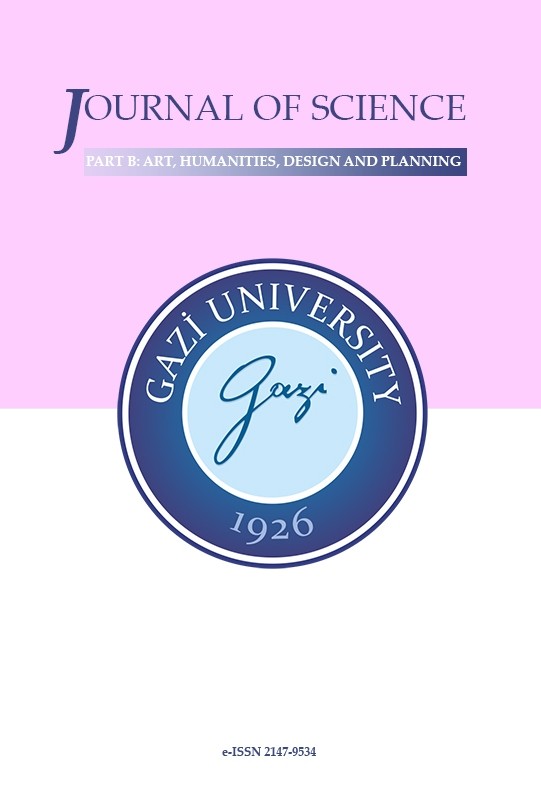MODULAR SYSTEM APPROACH IN DESIGN EDUCATION
MODULAR SYSTEM APPROACH IN DESIGN EDUCATION
Contemporary users expect portable, flexible, environment- and user-friendly, flexible designs. In order to meet these expectations, the design forms should be organic, ecological, alive, dynamic, flexible, adaptable, versalite, and portable. Thus, the concepts such as digital and smart architecture were introduced. Therefore, formation of natural material and the harmony in nature are the inspirations for design. Nature has a unique system, which is comprised of modules. Inspiration from the nature could help creation of a system in design education using modules, facilitating the design process for the students. Thus, the modular design process, which involves the adoption of modular design approach in landscape architecture education, was discussed in the present study. The analysis of the modules is important for these types of design. Thus, the present study addressed the concepts of inspiration from the nature and modular design within the context of “Architectural Design and Project Course”, which is one of the 2nd semester courses at Karadeniz Technical University, Landscape Architecture Department. The study material included models titled “urban objects” constructed in the above-mentioned course. In the application section, the models of 4 students were selected by the researchers and evaluated based on the research process (natural examples) and creative product (model) aspects. In conclusion, it was determined that the creation of design forms and spatial construct by students were facilitated in this design education that adopted the nature inspired modular approach.
Keywords:
Landscape architecture, modular design, natural inspiration,
___
- 1. Düzenli, T., Yılmaz, S. and Alpak, E. M. “Peyzaj Mimarlığı Eğitiminde Bir Tasarım Yaklaşımı: Doğal Örüntülerden Esinlenme”. SED Sanat ve Eğitim Dergisi, Cilt 6, Sayı 1, 21-35. (2018).
- 2. Düzenli, T., Alpak, E. M. and Özkan, D. G. “Transition from Intangible to Tangible in Landscape Architecture Basic Design Course”. European Online Journal of Natural and Social Sciences, 6(4): 516-525. (2017).3. Batmaz, S.K. “Tasarımda çeşitlenme sağlayan yöntemlerin günümüz mekan uygulamaları üzerinde incelenmesi”. Doctoral dissertation, İstanbul Kültür Üniversitesi/Fen Bilimleri Enstitüsü/İç Mimarlık ve Çevre Tasarımı Anabilim Dalı. (2013).4. Achim, M. “Computational Morphogenesis: Integral Form Generation and Materialization Processes”. In Proceedings of the 3rd International ASCAAD Conference on Em’body’ing Virtual Architecture. (2007).5. Petruccioli, A. and Kütükçüoğlu, B. “Bellek yitiminin ardından: Akdeniz İslam kent dokusunun öğrettikleri”. Yapı-Endüstri Merkezi Yayınları. (2008).6. Welsh R.P. “Theo Van Doesburg and Geometric Abstraction”. In: Bulhof F. (eds) Nijhoff, Van Ostaijen, “De Stijl”. Springer, Dordrecht. (1976).7. Turuthan, U. T. “Tasarlama Faaliyeti ve Tasarımcı Nitelikleri Üzerine Bir İnceleme”. Doktora Tezi, Karadeniz Teknik Üniversitesi Fen Bilimleri Enstitüsü, Trabzon. (1987).8. Bilir, S. “Mekân Tasarımında Kavram Geliştirme Sürecine Analitik Bir Yaklaşım”. Hacettepe Üniversitesi Güzel Sanatlar Enstitüsü.iç Mimarlık Ve Çevre Tasarımı Ana Sanat Dalı.iç Mimarlık Sanat Dalı, Yüksek Lisans Tezi, Ankara. (2013).9. Öymen Gür, Ş. “Mimaride Taklit Geleneği”, Mimarlık 333, Ocak-Şubat, (2007).10. Wolf, F. “The Tree Pleasures of Mimasis According to Aristotle’s Poetics”, Derleyen B. Bensaude-Vincent, “Artifical and the Natural: An Evolving Polarity”, Cambridge, (2007).
- 11. Arslan Selçuk, S. and Gönenç Sorguç, A. “Mimarlık Tasarımı Paradigmasında Biomimesis’in Etkisi”, Gazi Üniversitesi Mühendislik Mimarlık Fakültesi Dergisi, 22(2): 451–459. (2007).12. Öztürk, Ö. B. and Arayıcı, O. “Tasarım Eğitimi Kapsamında Bir Yöntem Önerisi: İmgesel Aritmetik”. 2nd International Conference on New Trends in Education and Their Implications 27-29 April, Antalya. (2011).13. Fer, S. “Modüler Program Yaklaşımı ve Bir Öneri”. Milli Eğitim Dergisi, 147: 21-37, ISSN 1301-7669. (2000).14. Bums, M. “About Teaching Mathematics. A K-8 Resource.” (2nd ed.) Sausalito, Califomia: Matlı Solutions Publication. (2000).15. Childs, K.M. “An Investigation of the Role of Patterns in Developing Algebraic Thinking”. Doktora Tezi, Texas A&M University. (1995).
- Yayın Aralığı: Yılda 4 Sayı
- Başlangıç: 2013
- Yayıncı: Gazi Üniversitesi
Sayıdaki Diğer Makaleler
SUSTAINABLE DESIGN APPROACHES FOR LIVEABLE WATERFRONTS
MODULAR SYSTEM APPROACH IN DESIGN EDUCATION
Tugba DUZENLİ, Serap YILMAZ, Abdullah ÇİĞDEM
DOCUMENTING RURAL ARCHITECTURAL HERITAGE: ANKARA FETHIYE VILLAGE
Özlem SAĞIROĞLU, Arzu ÖZEN YAVUZ
Utilization of Mongolian GER’s spatial configuration in modern housing
USING PARAMETRIC ALGORITHMS WITHIN THE CONTEXT OF ENERGY OPTIMIZATION OF BUILDING SKINS
Feyza Nur AKSİN, Semra ARSLAN SELÇUK
A REVIEW OF HAMMAMS OF THE SOUTHEASTERN REGION OF ANATOLIA
Emine EKİNCİ DAĞTEKİN, Zehra Gediz URAK
